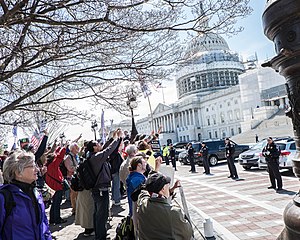Category Archives: Democracy Spring
Live video
Democracy Spring March Arrives In DC
Democracy Spring: Protesters Begin Day 1 of Sit-In and March In DC
Democracy Spring
|
|
This article’s introduction section may not adequately summarize its contents. (May 2016) |
| Democracy Spring | |
|---|---|

Democracy Spring protesters at the United States Capitol building, April 2016
|
|
| Date | April 2016 |
| Location | Washington, D.C. |
| Goals | Electoral reform |
| Status | Ongoing |
Democracy Spring is a coalition of “more than 100 progressive groups”[1] with a common interest in US federal legislation intended to reduce “the influence of money in politics” and “expand and protect voting rights“.
Actions[edit]
A group of Democracy Spring participants began a ten-day march from Philadelphia to Washington, DC,[3] on April 2, 2016. According to the Progressive Change Campaign Committee (PCCC), rallies and events have been scheduled at the United States Capitol through the weekend in an effort to “draw attention to our corrupt campaign finance system and rigged voting laws.”[2] The initial events received wide coverage on social media, and on outlets like NPR and CSPAN, but cable news networks devoted little time to the protests.[4]
The protest began with a rally and participants included progressive political commentator Cenk Uygur, actress Rosario Dawson, educator and activist Lawrence Lessig, filmmaker Annabel Park, Ben & Jerry’s founders, Ben Cohen, Jerry Greenfield,[5] and “many attendees sporting Bernie Sandersclothing and signs.”[1][3][6][7][8] Demonstrators slept in local churches and at a tent set up near Union Station with a permit.[9]
Arrests[edit]
The first day of nonviolent protest drew over 600 people to the United States Capitol building, where over 400 were peaceably arrested.[2] The group demanded a “Congress of conscience” pass laws related to voter representation that would encourage small political contributions, constrain large and undisclosed political contributions, endgerrymandering, and reinstate mechanisms from the Voting Rights Act.[1] The group also demanded a hearing for President Barack Obama‘s Merrick Garland Supreme Court nomination, which was postponed by the legislature. NPR found the event to be “cheery and peaceful” and a Capitol Police officer said that unless the protesters had outstanding warrants, they would “merely be processed, cited with a fine, and released.”[1][3]
Police arrested 85 activists on that second day, and organizers said it was the largest mass arrest at the Capitol building in history.[10] The second protest held hundreds of participants, many of whom were elderly.[10] More protests were planned daily throughout the week[1] and over 3,500 people across 33 states pledged to participate.[2] On the third day around 100 protesters were arrested.[11] A dozen protesters were arrested inside the Capitol building’s rotunda and 130 arrested outside on the fourth day.[12] The dozen indoor protesters had zip tied themselves to scaffolding in an attempt to occupy the Capitol building.[13] By Saturday, over 900 activists had been arrested in total over the week.[14] IVN reported that by Monday over 1200 had been arrested in total.[15]
Demands[edit]
According to its website,[16] the coalition has identified the following measures whose adoption would “restore the people’s voice in government”:
- Pass the Voting Rights Advancement Act (H. R. 2867, S. 1659)
- Pass the Voter Empowerment Act (H. R. 12)
- Pass the Democracy For All amendment (H. J. Res. 22, S. J. Res. 5)
- Pass the Government by the People & Fair Elections Now acts (H. R. 20 and S. 1538)
- Confirm a Supreme Court nominee that will end what is seen as undue corporate influence in the election process.